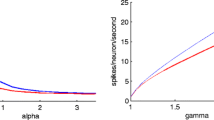Abstract
Many experimental results suggest that more precise spike timing is significant in neural information processing. From this point of view, we construct a self-organizing model using the spatio-temporal patterns, where Spike-Timing Dependent Plasticity (STDP) tunes the conduction delays between neurons. STDP forms smoother map with the spatially random and dispersed patterns, whereas it causes spatially distributed and clustered firings for spatially continuous and synchronous inputs. These results suggest that STDP forms cell assemblies having a fine structure reflecting external stimuli.
Similar content being viewed by others
References
Abeles M., Bergman H., Margalit E., Vaadia E. (1993). Spatiotemporal firing patterns in the frontal cortex of behaving monkeys, J Neurophysiol 70, 1629–1638
Aviel Y., Horn D., Abeles M. (2004). Synfire waves in small blanced networks. Neurocomputing, 58-60: 123–127
Bi G., Poo M. (1998) Acitivity-induced synaptic modifications in hippocampal culture:dependence on spike timing synaptic strength and cell type. J. Neuroscience 18: 10464–10472
Cateau H., Fukai T. (2001) FokkerPlank approach to the pulse packert propagation in synfire chain. Neural Networks. 14: 675–686
Diesmann M., Gewaltig M. O., Aertsen A. (1999) Stable propagation of synchronous spiking in cortical neural network. Nature. 402: 529–533
Guyonneau R., VanRullen R., Thorpe S.J. (2005) Neurons tune to the earliest spikes through STDP. Neural Comput. 17: 859–879
Hamaguchi K., Aihara K. (2004) Quantitative information transfer through layers of spiking neurons connected by Mexican-Hat-type connectivity. Neurocomputing. 58–60: 85–90
LeVay S., Wiesel T.N., Hubel D. (1980) The development of ocular dominance columns in normal and visually deprived monkeys. J. Comparative Neurol. 191: 1–51
von der Malsburg, C.: The Handbook of Brain Theory and Neural Network, The MIT Press, New York, 2003.
Markram H., Lübke J., Frotscher M., Sakmann B. (1997) Regulation of synaptic efficacy by coincidence of postsynaptic APs and EPSPs. Science 275: 213–215
Neurenschwander S., Singer W. (1996) Long-range synchronization of oscillatory light responses in the cat retina and lateral geniculate nucleus. Nature 379: 728–733
Sakai, Y.: Topological maps by STDP for input space with discrete and continuous features, IEICE Technical Report (in Japanese) NC2005-17 2005.
Song S., Abott L.F. (2001) Cortical development and remapping through spike timing-dependent plasticity. Neuron 32: 339–350
Wang Y., Fujita I., Murayama Y. (2000) Neuronal mechanisms of selectivity for object features revealed by blocking inhibition in inferotemporal cortex. Nature Neurosci. 3: 807–813
Author information
Authors and Affiliations
Corresponding author
Rights and permissions
About this article
Cite this article
Akimitsu, T., Okabe, Y. & Hirose, A. Self-Organization through Spike-Timing Dependent Plasticity Using localized Synfire-Chain Patterns. Neural Process Lett 25, 79–89 (2007). https://doi.org/10.1007/s11063-006-9032-7
Received:
Accepted:
Published:
Issue Date:
DOI: https://doi.org/10.1007/s11063-006-9032-7




